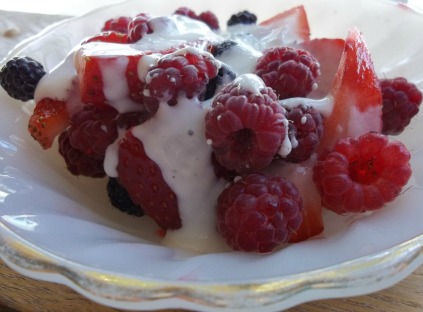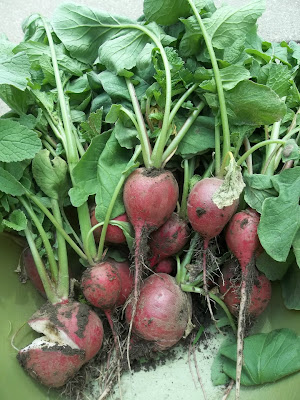Thanks for stopping by! For the most recent content, you can find me at A Housewife Writes.
Lately I keep running into people who want to learn how to make their own soap. Soapmaking can be an art form, most definitely, but it should also be a basic skill. After all, up until the last hundred years or so, nearly all housewives knew how to make the soap for their families' needs. Even though I make soap and sell it, I would like to see more people making their own. There's nothing quite as nice as making your own anything. So, R, I, and T--this tutorial is for you! (And for you, too.)
This is my version of a fruit/veggie wash soap, using just olive and coconut oils, based on this recipe from the
Soap Queen blog. It's a mild, unscented soap, and very simple to make. It's mild enough to use as a hand soap, as well.
Here are the very basic supplies you'll need--
I love
this mold from Bramble Berry, but it's not an absolute necessity. For the first several years of soaping, my primary molds were Rubbermaid plastic divider trays and a cardboard box that once carried cups of yogurt. (Just line your molds with freezer paper, shiny side up.)
Lye
Lye is absolutely essential to making soap--it can't be made without it. How else can you get oils and water to blend together and harden into a bar? Lye (sodium hydroxide) can be dangerous stuff, but with a dose of caution, it shouldn't scare you away from making soap. Take bleach, for example. You most likely have a bottle of it in your house, but you keep it away from children, avoid the fumes, don't use it on your bare skin and use it strictly according to the directions. Use the same precautions with lye. Just wear safety glasses and gloves and wear socks and long sleeves on the off chance the lye mixture happens to splash. You can also cover the counters with newspaper to make cleanup easier.
You can find lye at many hardware stores, in the plumbing aisle. Make sure it's 100% sodium hydroxide; for the record, Draino is not.
Measure as carefully as you can. You'll definitely want a scale, so you don't have soap that won't harden or the other extreme, soap that will strip the first layer of skin right off....or at least feel like it!
The Recipe
14 oz. coconut oil
8 oz. olive oil
3.5 oz. sodium hydroxide
8 oz. distilled water
Weigh out the oils, either altogether into the pan or separately before adding to the pan. Melt the oils over lowest heat. I use a stovetop but some use a microwave. I turn off the heat before all the coconut oil is melted and let the few remaining chunks melt on their own. You want the oils melted, not hot.
Measure the water into a stainless steel or plastic bowl (don't use glass or aluminum.) You'll notice that as you slowly sprinkle in the lye and stir to dissolve, the mixture heats up. I usually set the bowl in a sink containing a few inches of cold water so the lye mixture won't get too hot and will cool down more quickly. Stir carefully so you don't splash and make sure every lye crystal is dissolved.
 |
| The lye heating up the water |
 |
| All lye is dissolved. |
When the outside of the bowl is room temperature or slightly warm (not hot) to the touch, you are ready to mix with the oil. Carefully pour the lye mixture into the melted oils and stir it with a stick blender. You can also use a whisk, but it will take longer to thicken.
You will eventually notice that the mixture thickens and no longer separates. When you can drizzle a stream of soap across the surface and it doesn't sink back into the mixture, it has reached trace. It's now ready to pour into the mold.
 |
| See the drizzle across the top? |
Pour into a mold and just leave to sit on a counter until it hardens. I usually let it sit overnight (12 hours or so). You will be able to tell if it's too soft to cut. After it's cut/unmolded, I set the bars on pieces of plastic canvas to dry and cure for 4 agonizingly long weeks. After that, you can keep a bar next to your sink and use it to wash all your produce (and of course, impress everyone with your new skill.)
This is just a basic overview and if you find that you enjoy making your own soap, there are many sites to help you learn more about the science of soaping and how to make your own recipes with scents and colors.
Here is a great place to start and one of my favorite resources.
And that's it! You have a way to clean your produce--it's inexpensive, you know all the ingredients and you made it yourself! It's not so hard, huh?
 The original recipe includes grapes with coconut flakes sprinkled on top as well. I usually make up individual bowls, but you could also do as the recipe suggests, "Serve buffet style, in pretty bowl; top with small blobs of sour cream." (I subscribe to the "big blob will do ya" school myself...)
The original recipe includes grapes with coconut flakes sprinkled on top as well. I usually make up individual bowls, but you could also do as the recipe suggests, "Serve buffet style, in pretty bowl; top with small blobs of sour cream." (I subscribe to the "big blob will do ya" school myself...)
















































